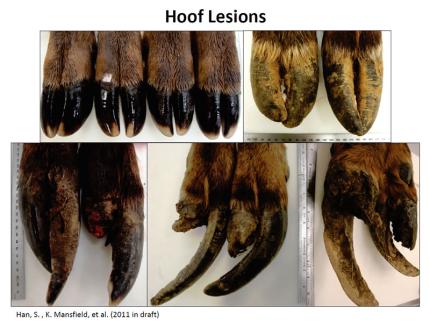
Since 2008, reports of elk with deformed, broken, or missing hooves have increased in southwest Washington, with some observations west of the Cascade Range. While elk are susceptible to many conditions that cause limping or hoof deformities, the prevalence and severity of this new affliction – now known as treponeme-associated hoof disease (TAHD) – suggests something different.
WDFW with a panel of independent scientists conducted diagnostic research that found that these abnormalities were strongly associated with treponeme bacteria, known to cause digital dermatitis in cattle, sheep, and goats. Although this type of disease has plagued the dairy industry for decades, TAHD had never before been documented in elk or any other hooved wildlife species.
Since then, WDFW has continued to work with scientists, veterinarians, outdoor organizations, tribal governments, and others through its Hoof Disease Technical Advisory Group and Public Working Group to develop management strategies for TAHD-infected elk.
Find out more about WDFW's pilot program to manage the prevalence of hoof disease.
Or learn more about hoof disease research being led by Washington State University's College of Veterinary Medicine.
Hoof disease observations
WDFW seeks to document and respond to the diseases that affect elk health in our state. You can help by reporting limping elk or dead elk with hoof deformities.
Report limping elk or elk with hoof deformities
About TAHD
Several aspects of TAHD in elk are clear:
- Susceptibility: The disease appears to be highly infectious among elk, but there is no evidence that it affects humans. TAHD can affect hooves of any elk, young or old, male or female.
- Hooves only: Tests show the disease is limited to animals' hooves, and does not affect their meat or organs. If the meat looks normal and if hunters harvest, process, and cook it practicing good hygiene, it is probably safe to eat.
- No treatment: Currently, there is no vaccine to prevent the disease, nor are there any proven options for treating it in the field. Similar diseases in livestock are treated by forcing them to walk through foot baths and cleaning and bandaging their hooves, but that is not a realistic option for free-ranging elk.
TAHD in Washington
WDFW has confirmed cases of elk afflicted with TAHD in 17 Washington counties, primarily in the southwest region of the state. Efforts to formally estimate the prevalence and distribution of TAHD indicate the disease is most prevalent in Cowlitz, Wahkiakum, and the western half of Lewis counties. In April 2018, WDFW confirmed the presence of the disease in Klickitat County – the first such finding in Washington east of the Cascade Range. WDFW detected TAHD in Walla Walla County in 2019 and in Kittitas county in 2020.
The Oregon Department of Fish and Wildlife has confirmed TAHD in elk populations in both western and eastern Oregon. The disease has also been confirmed in Idaho and recently in California.
How hunters and others can help
State wildlife managers are asking for your help to monitor and prevent the spread of TAHD in several ways:
- Leave hooves: Scientists believe that treponeme bacteria may persist in moist soil and spread to new areas on the hooves of infected elk. For that reason, WDFW encourages hunters in 400, 500, and 600 series game management units (GMUs) to remove the elk’s hooves and leave them onsite. If you harvest an elk in a 100, 200, or 300 series GMU, where the disease is uncommon, please keep any abnormal hooves and report your observation to the nearest WDFW regional office. WDFW will work with you to submit the hooves for diagnostic testing.
- Report elk: You can help WDFW track TAHD by reporting observations of healthy or limping elk and dead elk with hoof deformities using the reporting tools on this page.
- Clean shoes and tires: Anyone who hikes or drives off-road in a known affected area can help minimize the spread the disease to new areas by removing all mud from their shoes or tires before leaving the area.
Diagnosing and monitoring TAHD in elk
From 2009 - 2014, WDFW, the USDA National Animal Disease Center and four other diagnostic laboratories collected hooves and tissue from 43 elk to find the cause of the disease. The samples were taken from elk in areas affected and not affected by the disease.
By 2014, all five laboratories identified treponeme bacteria in the diseased elk samples, but not in those from healthy elk. This finding provided evidence of the role of treponeme bacteria in causing the disease. A WDFW technical advisory group, composed of the State Veterinarian's office, state public health officials, university researchers, and other specialists independently reviewed and accepted WDFW’s diagnostic research. .
Since then, WDFW continues to partner with leading experts to better understand this disease, and has initiated a variety of field studies to assess the distribution and prevalence of the disease, along with its effect on elk survival, reproduction and recruitment. WDFW is also working closely with Washington State University's College of Veterinary Medicine Elk Hoof Disease Research team, which the legislature designated legislature as the state lead in assessing the causes and potential solutions for elk hoof disease in 2017.
More Information
- Elk hoof disease likely causes systemic changes, WSU News, September 2023
- WSU researchers discover one way elk become infected with devastating hoof disease, WSU News, September 2021
- Severe Hoof Disease in Free-Ranging Roosevelt Elk (Cervus Elaphus Roosevelti) in Southwestern Washington, USA
- Contagious Ovine Digital Dermatitis (CODD)
- Geographical Distribution and Prevalence of Hoof Disease in Southwestern Washington Elk Based on Hunter Surveys
- Severe Hoof Deformities in Free-Ranging Elk in Western Washington State